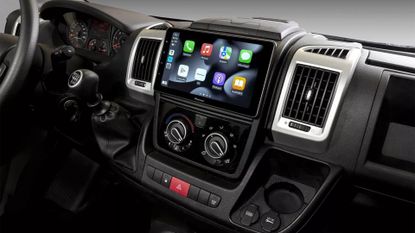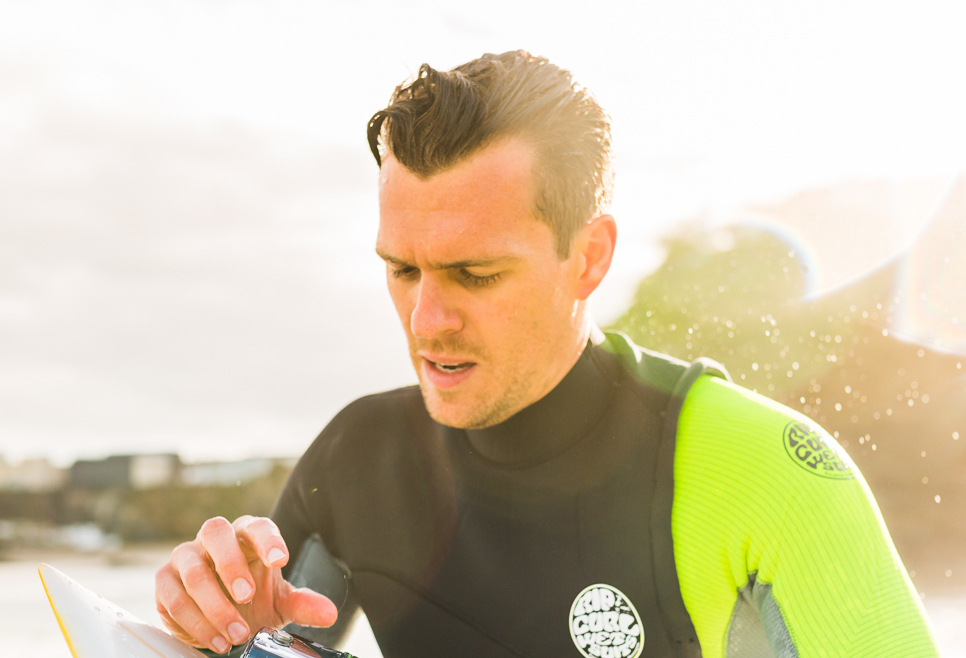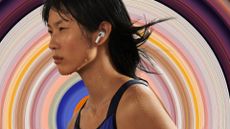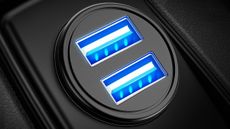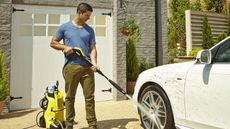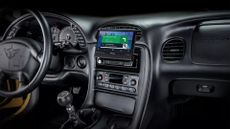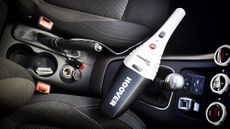We do everything with our smartphones these days and with the last iPhone count topping the 2.3 billion units shifted globally, it only seems logical that most drivers want to make the most of Apple's functionality when behind the wheel.
Of course, that's a little bit naughty and illegal here in the UK, unless you are interacting with your phone via Apple CarPlay, which essentially beams car-friendly apps directly to a touchscreen in the car.
Unfortunately, this connectivity has only really been rolled out in vehicles manufactured in the last five years or so, meaning anyone with slightly ageing wheels has to put up with a CD player and some crackly FM radio.
Not any more chums, because ensuring your ride is technologically bang up to date is simply the case of removing an old head unit or stereo system and replacing it with a much more accomplished and capable Apple CarPlay-enabled system from the likes of Pioneer, Sony, JVC and Kenwood.
Thanks to recent advances in slimline design and the continual shrinking of electronic gubbins, even those with smaller spaces (typically referred to as single DIN car stereos) can now enjoy the large and reactive touchscreens once the reserve of those lucky few with much newer vehicles.
So, if you fancy ditching that crackly FM radio and installing kit that happily chats to your iPhone, you need to check out the best car stereos and head units that money can currently buy.
While you're upgrading your vehicle, you can also check out the best dash cam, best car phone holders, and best car seat.
T3's top 3 Apple CarPlay head units
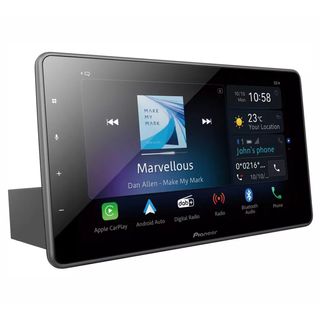
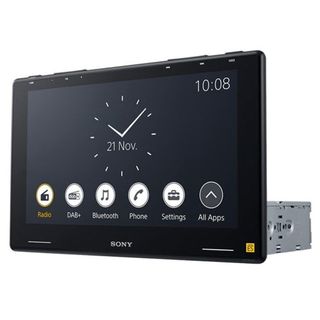
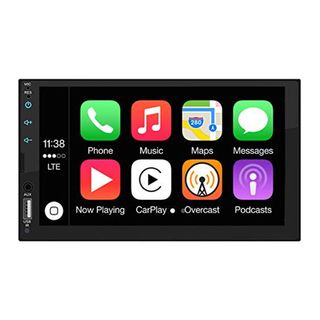
The best Apple CarPlay head units you can buy
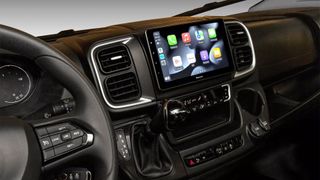
The Pioneer SPH-EVO950DAB is our pick of the bunch
The absolute best stereo system you can buy now is the recently refreshed Pioneer SPH-EVO950DAB Car Stereo, purely because its innovative design means even the oldest and most cramped car stereo spaces can now benefit from DAB+ digital radio, Apple CarPlay and all manner of modern connectivity (it’s even reverse camera compatible).
All of this is pumped through a beautifully crisp and rather revolutionary floating or tablet-style touchscreen display, which is a doddle to use and looks absolutely brilliant wherever it is installed.
Best overall
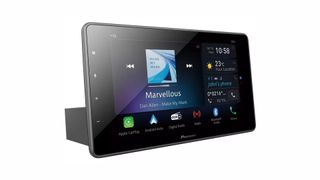

The Pioneer SPH-EVO range has been around for a number of years now and we have continually championed its slimline design, bright and responsive screen, excellent Apple mirroring abilities and ease of fitting.
Thankfully, the latest Pioneer SPH-EVO950DAB builds on everything that was excellent about previous iterations, but slims down the overall package even further, throws in a much faster and more responsive screen and extends the real estate, so you get a massive digital display in pretty much any vehicle with enough room to house it.
What’s more, Pioneer has stuck to its single DIN guns here, so this can be mounted in the smallest of spaces -typically those that once housed very basic FM radio tuners or single CD players - via a floating screen design.
Not everyone will be on board with this, but we've found it to be largely excellent, so long as you have the space in the cabin and don't mind a whopping touchscreen in your eyeline.
There’s the option of both wired (via a USB slot) and wireless Apple CarPlay and Android Auto, while the unit plays nicely with things like parking cameras, thanks to dual camera input for front and rear facing cameras (even those that are connected via Bluetooth), as well as hands-free kits for calls on the move and usage of your smartphone’s voice assistant.
Finally, there’s also a new feature that allows the user to adapt the colours and intensity of the display to suit your vehicle’s existing interior ambient lighting… should it be swanky enough to offer it.
Best premium
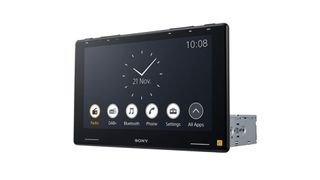
The old mantra "good things come in small packages" rings true here, as Sony has managed to cram a serious amount of technology into a slimline single DIN chassis.
A neat floating design sees the huge 10.1 inch high definition, capacitive touchscreen sit proud of the dash, meaning you’ll have to make sure it doesn’t block any key vehicle functionality that might be behind it but it will slot into most vehicles.
If you do have the space, it is a mightily powerful unit that boasts an ESS DAC chip, which boosts digital audio files for optimum sound quality. In addition to this, there’s wireless LDAC audio, which streams at bitrates three-times higher than Bluetooth.
Greater control over sound is provided by an eight-band parametric equaliser, in addition to the 24-bit DSP and 14-band equaliser that offer precision control over individual speaker distances and subwoofers.
Clearly not a head unit for shoving in your rusty old Renault Clio, this top end Sony offering can also take live feeds from three individual cameras, with automatic triggering by things like turn signals (for side cameras) and reverse gear for back-up cameras.
With full wireless connectivity for Apple CarPlay, the system itself is ultra-fast, ultra-convenient and ultra-customisable… and so it should be for that eye-watering asking price.
Best budget
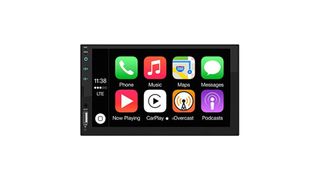
Sitting at the lower end of the price spectrum, this Automodz unit packs the basic features you need to get Apple CarPlay running in the car. The screen isn't particularly bright and it is slow to load, but it does exactly what you need it to.
There's a USB at the front of the unit for easy plugging in and some physical volume buttons for ease of use. The head unit also has an audio output of 45W x 4, which can help improve the overall quality of sound pumped into the cabin.
It's not particularly pretty or flash, but it does the job in hand well. Just bear in mind you'll need a large aperture to install this 7-inch screen.
Best styling
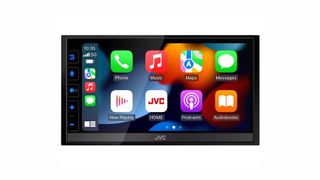
It appears JVC has listened to some of the feedback offered on its largely excellent KW-M745DBT unit and improved upon the recipe.
We bemoaned a lack of physical buttons in the previous editions, but this has been remedied… to an extent. Buttons are still part of the touchscreen itself but they are much larger and a damn sight easier to locate.
Even the colour scheme can be customised within the system menu, making them even simpler to operate in low light conditions. That said, the issue with a lot of these units is that the volume and operational controls tend to be on the left side of the unit, making it a fair old reach for us right-hand drivers in the UK.
However, JVC's system plays nicely with rear-view reversing cameras, with ready-made leads at the rear of the unit making it a doddle to install. With most modern vehicles, you’ll likely find there’s barely any need to tamper with existing wiring, it should be a largely plug and play operation.
The screen feels sharper and brighter, while the operating system is faster and more responsive than previous generations, including the start-up time, which now only takes a few seconds.
The only thing to note is its large double-DIN design, which requires a fair chasm of space on any vehicle’s dashboard.
Best for physical buttons
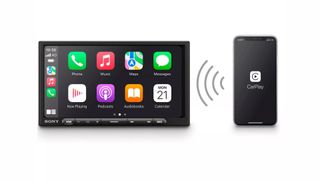
Sony now commands a much higher price for its XAV line, but it has made a number of improvements that allow it to compete with much more expensive rivals.
The screen is comparatively large at almost seven inches, but the addition of wireless connectivity means most will be able to run CarPlay or Android Auto without the trailing cables.
This is a real boon for those that want to keep a smartphone in the pocket (or out of sight) but still make the most of functionality, as built in Wi-Fi connectivity means favoured voice assistants can be used to navigate, make phone calls and skip music tracks.
What’s more, this is one of the few Apple CarPlay head units that includes physical buttons, and for that reason, it secures additional Brownie points from us.
The home, volume, skip track and voice keys are all mapped to slender switches at the bottom of the unit that can be located without taking eyes of the road.
The price is steep, but Sony throws in an external GPS arena, which will need to be safely routed and fitted to the vehicle, as well as an external microphone for crisp, hands-free calls. Again, this requires a little trim removal to safely tuck wires, but it’s worth the additional effort.
Best for smartphone addicts
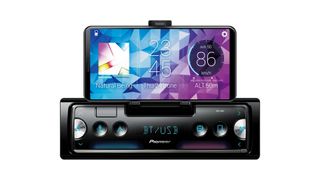
Who needs a big touchscreen when you can simply attach your smartphone? Of course, fiddling with your device on the move is frowned upon (and massively illegal), so Pioneer offers four dedicated hard key buttons for your favourite app access.
This one-touch access to favoured apps (such as Waze, Google Maps etc) makes it safer to use, while voice commands are arguably the best way to interact with the unit. Above all else, it’s a very affordable and clever way of achieving Bluetooth streaming, hands-free calls and neat phone charging on a slim budget.
Sure, it isn't real Apple CarPlay comparability, but it is a very cheap option for this on much tighter budgets.
Best for multiple phone pairing
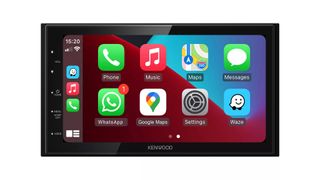
Although still officially a double DIN unit, Kenwood’s premium DMX-5020DABS features a "short chassis" design, meaning there is more room behind the system, making it much easier to install and cram in the required wiring.
The 6.8-inch touchscreen is sharp and colourful, with rapid response from touch inputs, while important keys are picked out in a bright contrast white light, making them easier to locate. That said, there is a lack of physical buttons here, which some find find irksome.
Still, Kenwood offers a 13 band EQ and digital sound processor that allows the perfect sound to be dialled in, while two RCA pre-outs allows additional amplifiers and speakers to be plugged in should you want to create a serious sound system.
Head around the rear and you’ll also be greeted by both AV in and out, which allows the expansion of further screens or the ability to plug in peripherals or a games console. The unit is also reverse camera-ready.
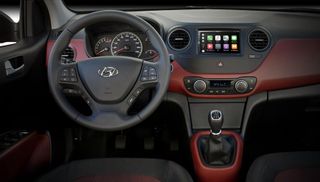
Fitting a new car stereo brings the interior bang up to date
How to buy a new head unit or car stereo
As previously mentioned, there is a new car stereo or head unit to suit most budgets and to fit most vehicles. So long as you have the existing wiring for some sort of stereo device, prices range from around £100 for the most basic unit with Apple CarPlay compatibility, while the most expensive can easily tickle the £1k mark if you opt for built-in maps and other jazzy features.
This, in our eyes, is a little bit pointless, because the whole point of this endeavour is to bring your iPhone into the car, meaning you pass the responsibility of software updates over to Apple and can hook up and charge while using Google Maps, Apple Maps or Waze to deliver you to a destination - much better than the ageing sat nav rubbish found on many infotainment systems. In reality, you shouldn't have to part with any more than £500 to get something utterly brilliant.
If you simply want a Bluetooth connection to play Spotify or listen to Podcasts, then it is very easy to shop at a much lower end of the budget (£90-£150). But true Apple CarPlay requires a touchscreen and that means parting with more cash.
On the subject of fitting, this can be done fairly easily for those with a bit of car-related knowledge, some tools and plenty of patience (check out the numerous YouTube How-To videos if you fancy a spot of DIY), but buy from from Halfords, for example, and they will offer to fit it for you.
This usually takes a couple of hours at the most and the cost around £99, depending on how complicated the fitting process is.
